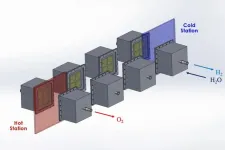(Press-News.org) URBANA, Ill. – Nanozymes are synthetic materials that mimic the properties of natural enzymes for applications in biomedicine and chemical engineering. They are generally considered too toxic and expensive for use in agriculture and food science. Now, researchers from the University of Illinois Urbana-Champaign have developed a nanozyme that is organic, non-toxic, environmentally friendly, and cost effective. In a newly published paper, they describe its features and its capacity to detect the presence of glyphosate, a common agricultural herbicide. Their goal is to eventually create a user-friendly test kit for consumers and agricultural producers.
“The word nanozyme is derived from nanomaterial and enzyme. Nanozymes were first developed about 15 years ago, when researchers found that iron oxide nanoparticles may perform catalytic activity similar to natural enzymes (peroxidase),” explained Dong Hoon Lee, a doctoral student in the Department of Agricultural and Biological Engineering (ABE), part of the College of Agricultural, Consumer and Environmental Sciences (ACES) and The Grainger College of Engineering at U. of I.
These nanozymes mimic the activity of peroxidase, an enzyme that catalyzes the oxidation of a substrate by using hydrogen peroxide as an oxidizing agent. They provide higher stability and lower cost than natural peroxidase, and they are widely used in biomedical research, including biosensors for detection of target molecules in disease diagnostics.
“Traditional nanozymes are created from inorganic, metal-based materials, making them too toxic and expensive to be directly applied on food and agriculture,” Lee said.
“Our research group is pioneering the development of fully organic compound-based nanozymes (OC nanozymes) which exhibit peroxidase-like activities. The OC nanozyme follows the catalytic activity of the natural enzyme but is predominantly based on agriculture-friendly organic compounds, such as urea acting as a chelating-like agent and polyvinyl alcohol as a particle stabilizer.”
The researchers also implemented a colorimetric sensing system integrated with the OC nanozyme for target molecule detection. Colorimetric assays, an optical sensing method, use color intensity to provide an estimated concentration of the presence of specific molecules in a substance, such that darker or lighter color indicates lower or higher quantity of target molecules. The organic-compound nanozyme performed on par with nanozymes typically used in biosensing applications within their kinetic profile with molecule detection performance.
“Traditional nanozymes come with a host of issues: toxicity, lengthy degradation, and a complex production process. In contrast, our nanozyme is quicker to produce, cost-effective, non-toxic, and environmentally friendly,” said Mohammed Kamruzzaman, assistant professor in ABE and co-author on the study.
Lee and Kamruzzaman applied the OC nanozyme-based, colorimetric sensing platform to detect the presence of glyphosate, a widely used herbicide in the agricultural industry. They performed colorimetric assays in solutions containing varying concentrations of glyphosate, finding the organic nanozyme was able to successfully detect glyphosate with adequate accuracy.
“There is an increasing demand for testing pesticide or herbicide presence in agricultural products to protect human and crop health. We want to develop an OC nanozyme-based, point-of-use testing platform for farmers or consumers that they can apply in the field or at home,” Kamruzzaman stated. “People would obtain a test kit with a substance to mix with their sample, then take a picture and use an app on their phone to identify the color intensity and interpret if there is any glyphosate present. The ultimate goal is to make the test portable and applicable anywhere.”
The researchers are also working on developing additional nanozymes, envisioning these environmental-friendly materials hold great potential for a wide range of applications.
The paper, “Organic compound-based nanozymes for agricultural herbicide detection,” is published in Nanoscale [doi.org/10.1039/D3NR02025H].
END
U of I researchers develop organic nanozymes suitable for agricultural use
2023-10-16
ELSE PRESS RELEASES FROM THIS DATE:
Women at much higher risk of depression after traumatic brain injury, analysis finds
2023-10-16
SAN FRANCISCO — Women are nearly 50% more likely than men to develop depression after suffering a concussion or other traumatic brain injury (TBI), according to an analysis of nine studies and nearly 700,000 people presented at the ANESTHESIOLOGY® 2023 annual meeting.
“Most studies showing the link between TBI and depression have focused on men,” said Isaac G. Freedman, M.D., MPH, lead author of the study and an anesthesiology resident at Massachusetts General Hospital and Harvard Medical School, Boston. ...
Argonne to receive new funding to develop quantum networks
2023-10-16
Quantum networks hold enormous potential for groundbreaking advances in many areas of science and technology. Once this technology matures, it is expected to be an essential component of quantum computing. It could have the equivalent impact as the internet has had on digital communication.
The U.S. Department of Energy (DOE) has announced that three collaborative projects in quantum networking will receive $24 million for up to three years. The DOE’s Argonne National Laboratory will ...
Hillman grant for Penn Nursing professor to study virtual reality & loneliness
2023-10-16
PHILADELPHIA (October 16, 2023) – Penn Nursing, with partners from the Annenberg Virtual Reality ColLABorative and New York University’s Rory Meyers College of Nursing, have been awarded 2023 grant from the Hillman Emergent Innovation: Serious Illness and End of Life program to study the use of social virtual reality (VR) in enhancing the treatment experience and reducing loneliness in people undergoing hemodialysis. This grant is awarded by The Rita and Alex Hillman Foundation.
Hemodialysis is a life-saving treatment for people experiencing ...
High-performance ICUs reduce mortality rates during pandemics and other health crises
2023-10-16
A new study published by CHEST Science Journal shows that high-performance intensive care units (ICUs) might also have better patient outcomes during health crises. The study used as a benchmark the mortality rate observed in Brazilian ICUs before and during the COVID-19 pandemic, and analyzed data from over 380,000 patients of private hospital ICUs across 10 Brazilian states. The research was coordinated by the D'Or Institute for Research and Education (IDOR) and concluded that the mortality rate during the pandemic was significantly reduced in ICUs that exhibited high efficiency before the pandemic.
The COVID-19 ...
Information about abortion care largely omitted or buried on 80% of health systems’ patient-facing websites
2023-10-16
Embargoed for release until 5:00 p.m. ET on Monday 16 October 2023
Annals of Internal Medicine Tip Sheet
@Annalsofim
Below please find summaries of new articles that will be published in the next issue of Annals of Internal Medicine. The summaries are not intended to substitute for the full articles as a source of information. This information is under strict embargo and by taking it into possession, media representatives are committing to the terms of the embargo not only on their own behalf, but also on behalf of the organization they represent.
----------------------------
1. Information ...
Andrea Califano receives Alfred G. Knudson award from NCI
2023-10-16
Andrea Califano, Dr, has been honored with the 26th Alfred G. Knudson Award in Cancer Genetics by the National Cancer Institute (NCI) for his exceptional contributions to the field of cancer research. Califano, a pioneer in the field of cancer genetics, is the Clyde and Helen Wu Professor of Chemical and Systems Biology at Columbia University Vagelos College of Physicians and Surgeons and a member of the Herbert Irving Comprehensive Cancer Center.
The award is named in honor of geneticist and cancer researcher Alfred G. Knudson, MD, a 1947 graduate of the Vagelos College of Physicians and Surgeons, who helped uncover several major genetic mysteries behind ...
Learning more about how cancer affects stroke risk
2023-10-16
Patients with a previous or current cancer diagnosis are more likely to have a stroke than the general population, but how are specific cancers and treatments associated with stroke risk?
A collaborative team led by University of Cincinnati, University of North Carolina (UNC) and Duke University researchers is seeking to answer that question.
Soma Sengupta, MD, PhD, now division chief of neuro-oncology at UNC, had the idea to study the prevalence of stroke in patients with different cancer types while a faculty member at UC. She recruited a team that included stroke experts Stacie Demel, DO, PhD, of UC and Wuwei Feng of Duke to put together a retrospective pilot study.
“This ...
MIT design would harness 40% of the sun’s heat to produce clean hydrogen fuel
2023-10-16
MIT engineers aim to produce totally green, carbon-free hydrogen fuel with a new, train-like system of reactors that is driven solely by the sun.
In a study appearing today in Solar Energy Journal, the engineers lay out the conceptual design for a system that can efficiently produce “solar thermochemical hydrogen.” The system harnesses the sun’s heat to directly split water and generate hydrogen — a clean fuel that can power long-distance trucks, ships, and planes, while in the process emitting no greenhouse gas emissions.
Today, hydrogen is largely produced through processes that involve natural gas and other fossil fuels, ...
Fungal infection in the brain produces changes like those seen in Alzheimer’s disease
2023-10-16
Previous research has implicated fungi in chronic neurodegenerative conditions such as Alzheimer’s disease, but there is limited understanding of how these common microbes could be involved in the development of these conditions.
Working with animal models, researchers at Baylor College of Medicine and collaborating institutions discovered how the fungus Candida albicans enters the brain, activates two separate mechanisms in brain cells that promote its clearance, and, important for the understanding of Alzheimer’s disease development, generates amyloid beta (Ab)-like peptides, toxic protein ...
Jefferson Lab to lead $300+ million high performance data facility hub
2023-10-16
NEWPORT NEWS, VA – The U.S. Department of Energy has just announced the selection of Thomas Jefferson National Accelerator Facility as the lead for its new High Performance Data Facility Hub. Jefferson Lab will partner with DOE’s Lawrence Berkeley National Laboratory to form a joint project team led by Jefferson Lab. The HPDF will be a $300-500 million computing and data infrastructure resource that will provide transformational capabilities for data analysis, networking and storage for the nation’s research enterprise. ...






